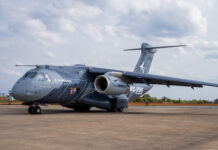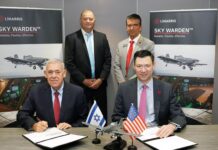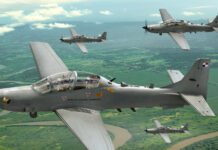This article examines some of the key recent developments in the air refuelling tanker space.
Tanker aircraft programmes worldwide reflect shared challenges. Tankers based on airliner designs – the vast majority of those now in service – may prove vulnerable to future threats. The need to increase tanker availability has led to NATO’s multinational tanker force and expanded use of commercially operated aircraft. The ability to refuel unmanned aerial vehicles (UAVs) and make use of enhanced capabilities for autonomous flight operations are near-term objectives for many tanker users, as is increasing network connectivity and situational awareness. This is reflected in upgrades to current tankers and in next-generation designs, especially those for the US Air Force (USAF).
The USAF’s workhorse – KC-46A
The Boeing KC-46A Pegasus tanker programme, the largest in the world, has ten of its 13 agreed upon firm-fixed-price production lots under contract, only 40 short of its USAF end-strength of 183 (recently increased from 179) aircraft. The fiscal year (FY) 2025 budget request, submitted in March 2024, included the eleventh production batch of 15 aircraft. The last production lots are scheduled to be put under contract in 2027, with deliveries concluding two years later. By mid-2024, over 90 KC-46As had been delivered to the USAF and 83 were operational with Air Mobility Command (AMC). International sales include four for Israel, six for Japan and, possibly, six for Italy, under negotiation since 2022.
Though a mature design, the KC-46’s capabilities have been overshadowed by unresolved deficiencies. It has not yet achieved its initial operational capability (IOC), originally scheduled for 2017. The six Category I (major) deficiencies include problems with the boom operator’s remote viewing system (RVS), boom stiffness, and supply chain and labour issues. Under the current contract, Boeing is responsible for the costs of correcting all deficiencies. This has cost Boeing some USD 7 billion as of 2023, with a further USD 128 million for the first quarter of 2024.
In 2024, the upgraded RVS 2.0, developed by Boeing and its main subcontractor, Collins Aerospace, has been submitted to the US Federal Aviation Administration (FAA) for certification. Its improved optics allow night refuelling without lights. The RVS 2.0 is to be fitted to KC-46As starting in October 2025.
Boom stiffness – preventing fuel flow when a receiver aircraft is not generating sufficient thrust – is being addressed with an upgrade package including a new actuator. It is scheduled to complete development in FY 2025.
The Wing Aerial Refuelling Pod System (WARP) for drogue refuelling resumed testing in March 2023, including demonstrating capability to refuel Navy and Marine Corps aircraft. It has not yet been used operationally pending certification by the FAA. Its initial operation test and evaluation (IOT&E), scheduled for April 2023, is now postponed until later in 2024. A modification to the refuelling boom to allow it to refuel probe-equipped aircraft, similar to the current ‘Iron Maiden’ for KC-135 booms, underwent testing in 2024.

Credit: US Navy/Erik Hildebrandt
A Department of Defense (DoD) report stated that in 2023, the KC-46A operational readiness and mission capable rates “remained steady at well below their threshold requirements”. However, since 2022, the KC-46A has been successfully flying missions and taking part in exercises worldwide, including 2023’s Mobility Guardian, Copper Arrow and Air Defender and the 2024 Bamboo Eagle. By 2023, KC-46As had logged 18,600 flights, 104,000 boom aerial refuelling contacts and 83 million kg (183 million lb) of fuel offloaded. It has been cleared to use its centreline boom to refuel all USAF aircraft except the Fairchild A-10, though the latter limitation may be waived in the future if required for operations.
A June 2022 request for information (RFI) to industry for tanker upgrades transferable to new designs reflects AMC’s emphasis on network connectivity; its ‘25 by 25’ programme aims to upgrade communications and command-and-control equipment on 25% of the AMC fleet by 2025. General Michael ‘Minnie’ Minihan, AMC commander, said in Aurora Colorado on 13 February 2024, “I can join the network, I can use it to be successful, but I can also give it away just like I give away gas in the air, give away situation awareness, give away connectivity, give away that battlespace awareness.”
In March 2023, Boeing was awarded a contract worth USD 184 million for the KC-46A Block 1 upgrade, including secure line-of-sight (LOS) and beyond-line-of-sight (BLOS) communications and airborne battle management system (ABMS) connectivity. Other KC-46A upgrades under development include providing boom operator in-the-loop autonomous air refuelling. An upgraded defensive systems suite, developed by Boeing with its subsidiary Aurora Flight Sciences, was announced at the 2023 Paris Air Show.
Future USAF tankers
The previous ‘bridge tanker’ and the ‘KC-Y’ programmes reflected the USAF’s objective to keep the tanker in production in the years after the current KC-46A production is completed in 2029 and until the next-generation aerial-refuelling system (NGAS) – previously designated KC-Z – enters service around 2035. The USAF’s current KC-135 Tanker Recapitalization programme – with the objective of replacing about 15 KC-135s per year to meet the current congressionally mandated air refuelling inventory of 466 aircraft – includes both the bridge tanker/KC-Y and the NGAS/KC-Z.
An analysis of alternatives (AoA) study started in October 2023 provides an analytical framework for all new tanker requirements. The USAF is planning to decide on its acquisition strategy this year and issue a request for proposals in 2025. The Future Tankers Program Office will be stood up in 2025. Production funding is planned to start with the FY 2027 budget request.
Issuing a request for information (RFI) to industry in September 2023, the USAF did not commit to holding a competitive evaluation, retaining the option to negotiate a sole-source contract with Boeing to continue KC-46 production for 75–150 ‘bridge tankers’. The final decision on whether the USAF will be able to do this, however, belongs to Congress.
In October 2023, Lockheed Martin withdrew its LMXT design from ‘bridge tanker’ consideration; the design was a modified version of the Airbus Military A330 MRTT (multi role tanker transport), but without its underwing probe-and-drogue refuelling pods, large cargo door and airlift capability. It would instead have additional fuel tanks with a 12 tonne capacity and expanded communications and command and control capabilities, including three mission specialist aircrew. Lockheed Martin announced it would instead concentrate on an NGAS design.
Airbus USA is continuing to offer the current A330 MRTT design. However, without a major US industry partner (and their foremost congressional supporter leaving office in January 2025), Airbus USA faces an uphill effort. The USAF’s goal of reducing the number of different types of aircraft in service – prioritising replacing McDonnell Douglas KC-10 Extender tankers by KC-46As – would make this unlikely without strong Congressional intervention.
In January 2023, the USAF issued an RFI for the NGAS, resulting in some 100 responses. It was followed in March 2024 by an RFI for engines suitable for the NGAS. The USAF is planning for a competition between potential NGAS designs. A decision on the future of the NGAS programme is anticipated in summer 2024, leading to a start in FY 2025, with aircraft entering service around 2035 and achieving IOC by 2040. On 8 March 2023, speaking in Orlando Florida, Secretary of the Air Force Frank Kendall, described NGAS as potentially a ‘family of systems’. More than one design, possibly including UAVs, may be procured.
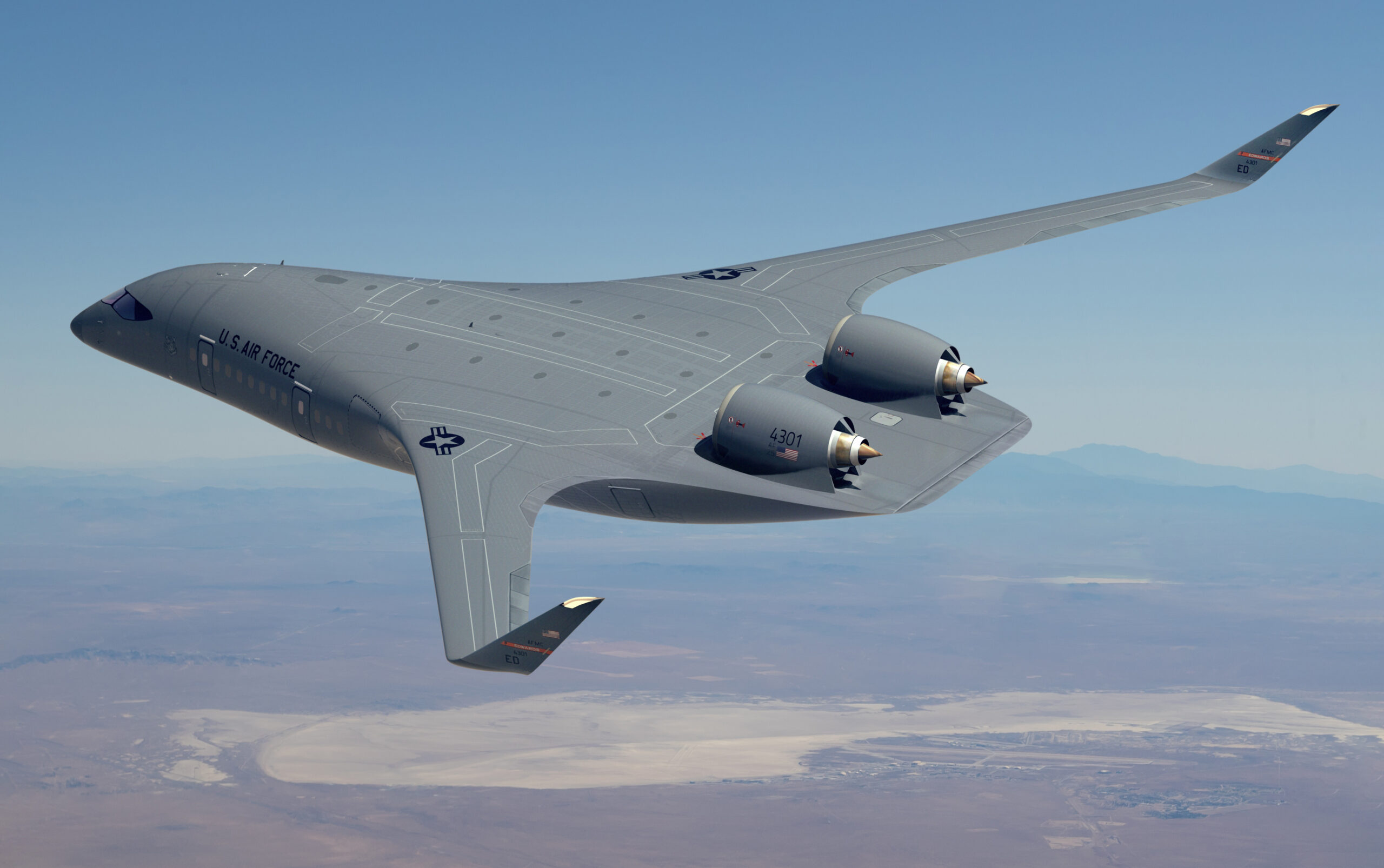
Credit: JetZero
The USAF currently envisions that the NGAS will – unlike current tankers – be a clean-sheet design rather than a modified airliner, which is likely to result in greater costs in both research and development and procurement. The Air Force’s tolerance for risk and the need to replace aging KC-135s are likely to have been affected by the KC-46A’s long-running deficiencies. The Air Force, since it first moved to replace KC-135s in 2002, has made reducing risk and avoiding competition (both, at times unsuccessfully) pillars of its tanker acquisition strategy. Whether this approach will be applied to the NGAS remains to be seen.
What the USAF may be looking for in the NGAS was suggested when it contracted for a study in August 2023 for a blended-wing-body (BWB) design from a JetZero-Northrop Grumman team. A BWB technology prototype, developed by the Air Force and the Defense Innovation Unit (DIUx) and built by JetZero, is scheduled to fly in 2026. Its lightweight structure and advanced engines provide half the fuel burn rate of aircraft in the same weight class. A subscale technology development model with a 23-foot wingspan will fly in 2024.
Although a commercial-derivative aircraft has not been explicitly ruled out, NGAS may be smaller, stealthier and able to operate inside contested environments in the face of the weapons systems expected in the 2040s. Tankers are likely to prove more survivable in the air than on the ground, making the capability to operate from dispersed forward airfields valuable. The USAF has identified “reduced runway take-off distance”, along with fuel offload capability and survivability, among desired NGAS characteristics. A Lockheed Martin notional NGAS ‘tactical tanker’ design from their Skunkworks organisation includes stealth features, a 13,608 kg to 45,360 kg (30,000 lb to 100,000 lb) fuel capability and extensive defensive and situational awareness systems.
KC-135 upgrades
The USAF’s Boeing KC-135 Stratotankers will remain in service until NGAS production is complete, in the 2050s. Since they were built in the 1950s and 60s, the KC-135 fleet has received engine replacements, upgraded radars, global positioning system (GPS) and modern cockpit displays; the Future Tanker Program Office will assume responsibility for KC-135 upgrades starting in 2025.

Credit: USAF/Capt Jose Davis
“We need to extract full value from things that already exist to make the best use of the force we have”, General Minihan said on 13 February 2024. The objective of providing a fleet-wide KC-135 BLOS capability started with a 2020 RFI to industry. A long-running programme to provide the KC-135 fleet – scheduled to be completed in FY 2027 – with Real-Time Information in the Cockpit (RTIC) systems connected to Link 16 and Situational Awareness Data Link (SADL) networks, with a digital moving-map cockpit display.
In 2023, during Exercise Mobility Guardian, a KC-135 was fitted with the Tanker Intelligent Gateway (TIG) communications node, based on the systems used in the E-11A Battlespace Airborne Control Node (BACN), including a roll-on/roll-off gateway, satellite communication and tactical networks including the Advanced Tactical Data Link (ATDL) and the Secret and Non-classified Internet Protocol Router Networks (SIPRNet/NIPRNet). Developed under a Cooperative Research and Development Agreement (CRADA), the TIG is transitioning to become an upgrade programme, although no date for an IOC has been announced. The TIG will be a follow-on to the AN/USQ-175 Roll-On Beyond-Line-of-Sight Enhancement (ROBE) system that has been available for a limited number of active force KC-135s since 2001. In March 2024, the Air Force issued an RFI to industry for the Commercial Access to NIPRNet and SIPRNet (CANS) programme to provide commercial Ku-band SATCOM capabilities for 325 KC-135s, starting in FY 2025.
The Northrop Grumman AN/ALQ-24 (V) Large Aircraft Infra-Red Counter Measures (LAIRCM) Block 30 system for the KC-135 is currently in full rate production, which began in 2019. In 2023, the Air Force tested a prototype Pack and Transport Reloader (PATR) crane, which can be fitted to a KC-135 cargo door to enable operations from dispersed airfields.
Boeing MQ-25 Stingray
Intended to be the first operational UAV tanker, the US Navy programme of record is for 70 Stingrays. Production will start with 21 air vehicles in FYs 2025–29 and run through the mid-2030s. While the Stingray development has focused to date on its primary tanker mission, the Navy’s 2023 aviation vision document made it clear that Stingray would, “pave the way for unmanned air vehicles on the carrier and manned and unmanned teaming (MUM-T)”.
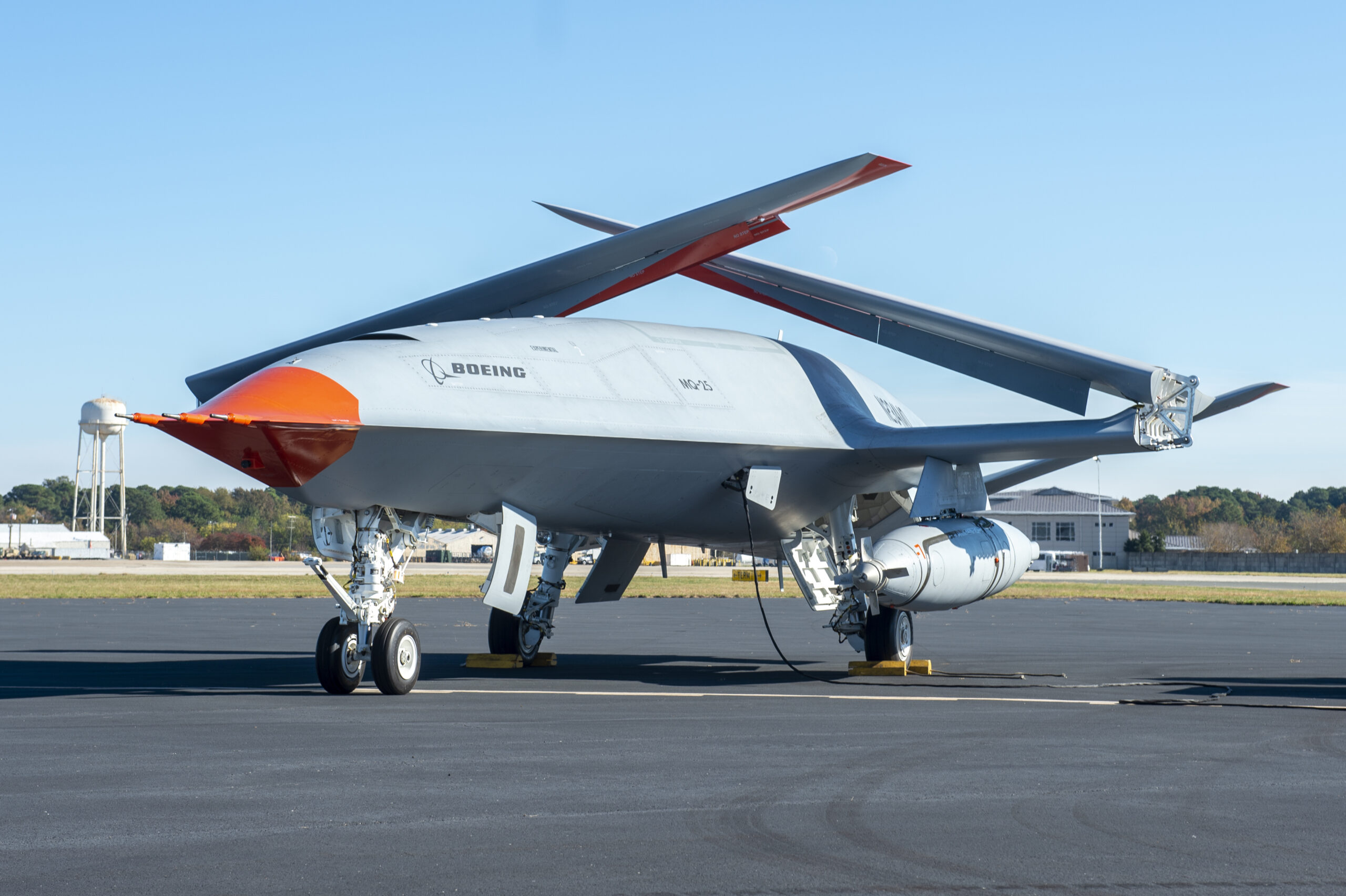
Credit: US Navy/Spc 2nd Class Sam Jenkins
Since the Milestone B decision to enter engineering and manufacturing development (EMD) in 2018, the Stingray has encountered a series of programmatic and technical problems. The DoD Inspector General issued a report in November 2023 recommending delaying the programme as it will require an intense testing effort to meet the revised IOC date of mid-2026, although Boeing has said that it is currently on schedule, with seven aircraft planned as being available for test and evaluation, with static testing in progress and the flight programme planned to restart in May–June 2025. This will be followed by catapult and arresting gear testing at Joint Base McGuire–Dix–Lakehurst (formerly, Naval Air Engineering Station (NAES) Lakehurst), New Jersey, later in 2025 and sea trials in 2026. Initial testing and evaluation will complete in FY 2027, followed by initial operational testing and evaluation (IOT&E).
On 21 February 2024, Boeing announced delivery of its first Stingray to the US Navy, for “rigorous airframe integrity airframe integrity evaluation.” The FY 2025 budget request included funding for procuring the first three low-rate initial production (LRIP) Stingrays. This was followed by a contract for two additional system demonstration test aircraft (SDTA) for the Navy. Boeing has contracted with BAE Systems to upgrade the Stingray’s vehicle management system computer (VMSC), controlling all flight surfaces as part of an upgrade effort to provide state-of-the-art components and systems on the Stingray.
In April 2024, five Stingrays were in production, which is in the process of being shifted from St. Louis to a new, dedicated facility at Mascouthah Illinois in June, where the first new builds will emerge in September-October.
In May 2024, Boeing announced the validation of MUMT software that would allow an F/A-18 pilot, as well as the controller aboard an aircraft carrier to control a Stingray while refuelling. Juan Cajigas, Boeing’s director, Advanced MQ-25 programme, said, “To be able to direct the activities via a single pilot, safely and efficiently, is a major step forward in aerial refuelling technology.”
Airbus A330 MRTT
In March 2023, NATO’s Multinational MRTT Fleet (MMF) of Airbus Defence and Space A330 MRTT aircraft achieved initial operational capability (IOC). Full operational capability (FOC) is scheduled for the end of 2024, with the delivery of the final three of ten operational tankers. The A330 MRTT has been sold to 14 countries: Australia, France, the Republic of Korea, Saudi Arabia, Singapore, Spain, the United Arab Emirates, the United Kingdom, and MMF members Belgium, the Czech Republic, Germany, Luxembourg, The Netherlands and Norway. It has also been selected by Canada, India and Indonesia. Commercially-owned government-operated (COGO) MRTTs include those of AirTanker, which operates 14 Voyager aircraft on behalf of the UK Ministry of Defence, with nine in direct support of the RAF and five available to third parties when not required for operations.
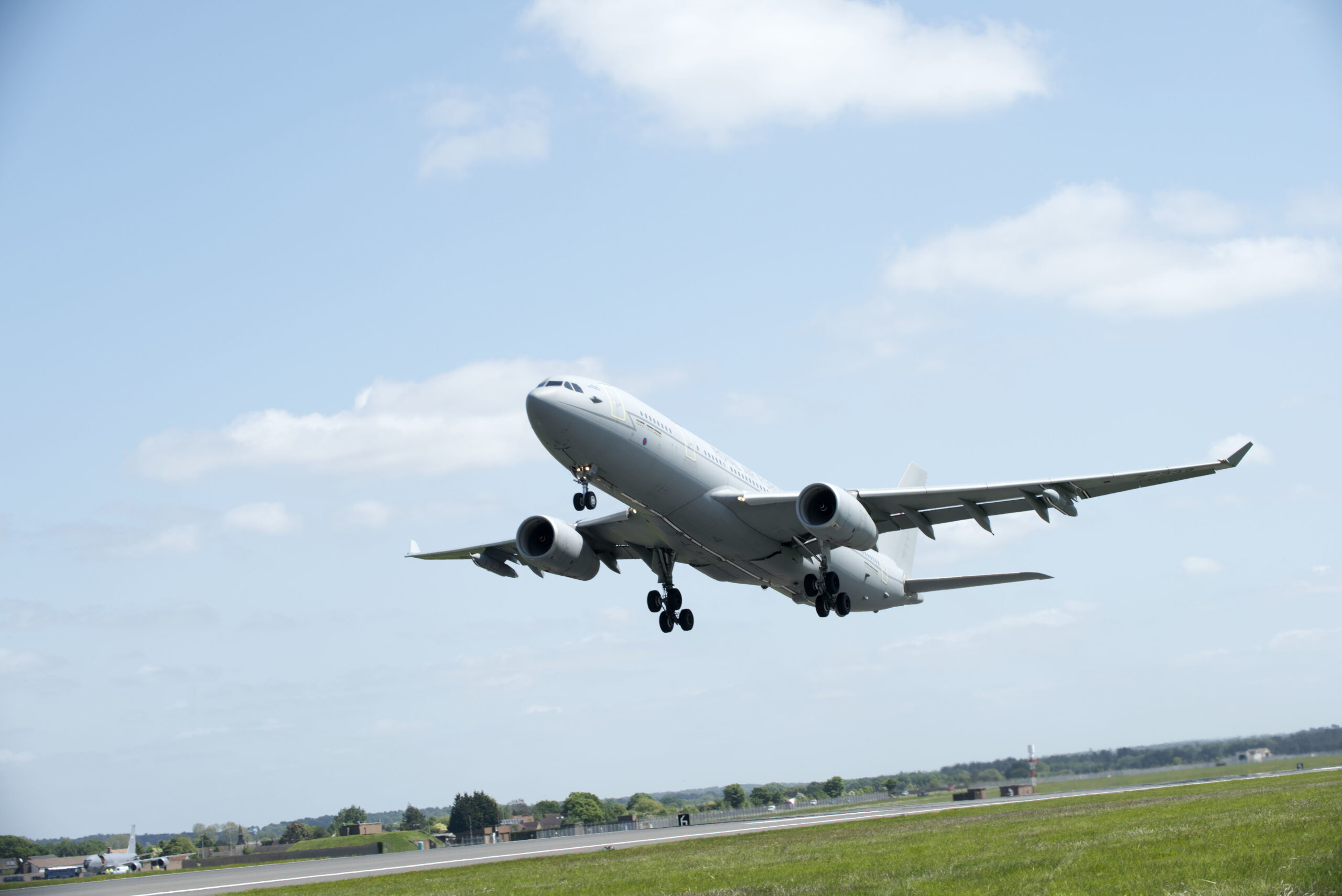
Credit: USAF/Senior Airman Christine Groening
Following proof-of-concept testing with Australian tankers in 2018, the A330 MRTT automatic air-to-air refuelling capability (A3R) was certified for daylight operations in 2022. This allows the boom operator to monitor the operation while retaining an override capability. In August 2023, the Republic of Singapore Air Force (RSAF), which partnered with Airbus in A3R development, carried out testing, making use of the Upgrade 3 refuelling booms fitted to its MRTTs, in day, night and all-weather conditions. The RSAF achieved IOC with A3R, the first service to do so. The RSAF used A3R during Exercise Forging Sabre in the US in September 2023.
Building on A3R, Autonomous Assets Air-to-Air Refuelling (A4R) capability will provide MRTTs with capabilities to refuel UAVs. In March 2023, Airbus Defence demonstrated its A4R AutoMate technology, including in-flight autonomous guidance and control of a DT-25 drone receiver aircraft to a simulated refuelling approach position, using an MRTT. The drone was controlled and guided by the tanker. A demonstration of the full A4R system is scheduled for later in 2024.
Upgrades in communications are being carried out by multiple MRDD operators. The RAF first announced in 2019 its interest in expanding the command, control and communications (C3) capabilities of its Voyager MRTT tankers. France is upgrading its 15 MRTTs to Standard 2 configuration with enhanced communications relay and command and control capabilities. The final MRTT will be delivered in this configuration in 2028 and the remainder will be retrofitted. Australia began upgrading its seven MRTTs in 2023, with enhanced communications, including datalink connectivity. The upgrade programme is scheduled to be completed in 2025.
Airbus has initiated development of a new MRTT, replacing the current airframe design, based on the A330-200 airliner with one based on the more-advanced A330neo, powered by Rolls-Royce Trent 700 engines, which could enter production by 2030.
Embraer KC-390
Intended to provide a quick-change capability for the Embraer KC-390 transport – around four hours to be modified into a tanker using underwing drogue pods and a 3992 kg (8,800 lb) capacity auxiliary tank in the main cabin – the KC-390 has expanded the number of aircraft types it has been cleared to refuel.
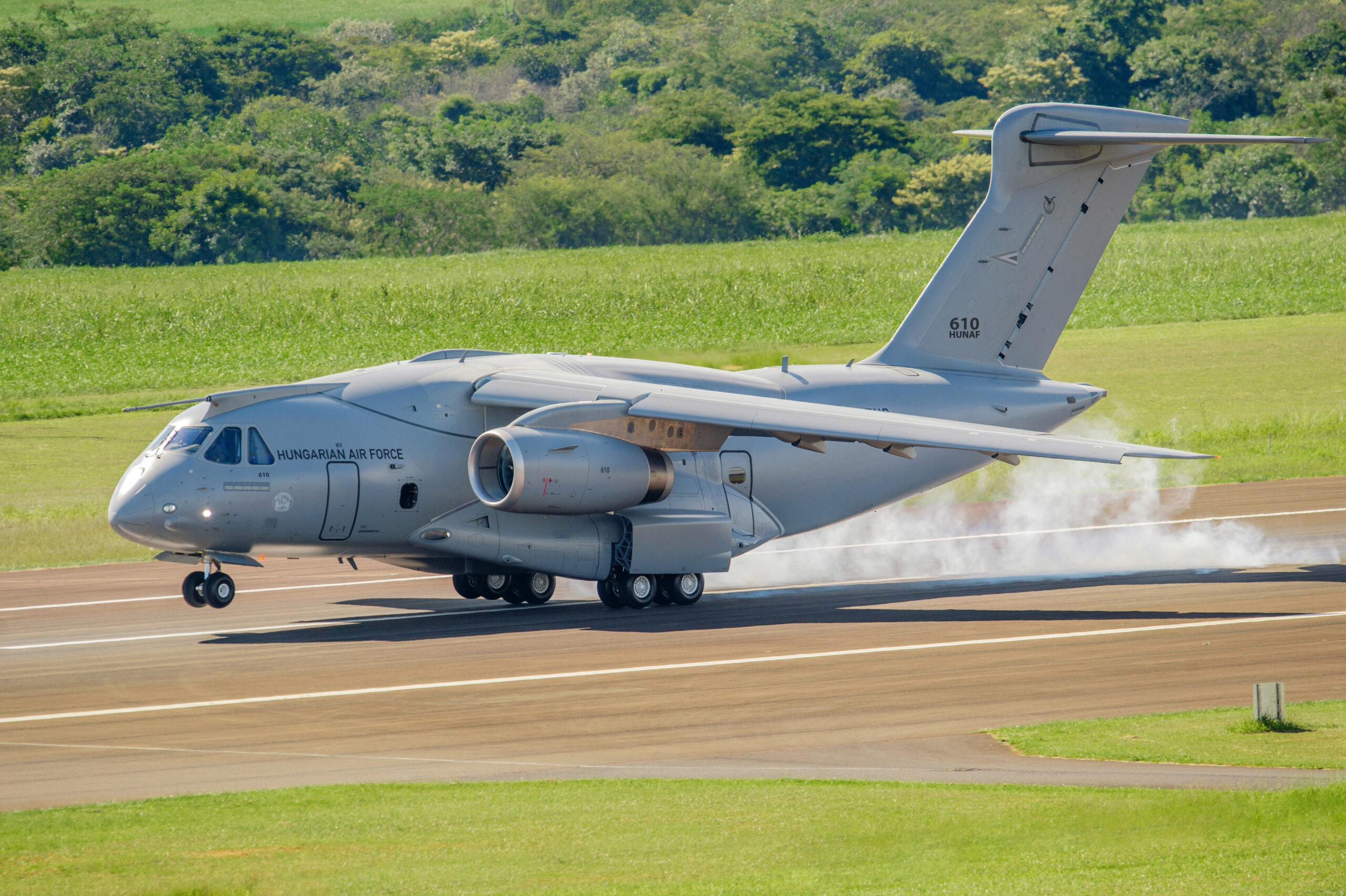
Credit: Embraer
As of 2024, some 50+ have been ordered by Austria, Brazil, Hungary, The Netherlands, Portugal and the Republic of Korea. While Hungary and the Czech Republic both ordered two, including refuelling capability, it remains uncertain how many of the others will be used in the transport role.
Embraer has continued to hold open the prospect of US production for the KC-390. Embraer and L3Harris Technologies have offered a KC-390 with a ramp-mounted boom refuelling system as a ‘tactical tanker’, able to operate from forward airfields and capable of taking off on 1,500 m (5,000 ft) runways.
PLAAF tankers
China has expanded its tanker force, mainly based in central and southern China, from one brigade with three Ilyushin Il-78M ‘Midas’ aircraft (purchased from Ukraine in past decades) and about 15 Xi’an Aircraft Company (XAC) H-6U and H-6DU tankers using the 1950s-vintage Soviet-designed Tu-16 ‘Badger’ airframe design, whose RDC-1 refuelling pods are reportedly incompatible with modern Chinese combat aircraft.
These are being replaced by newly delivered XAC YU-20A/B heavy airlifters with a removable fuel tank in the cargo bay and underwing RDC-3 probe and drogue refuelling units, each capable of transferring 1,600-2,300 litres per minute. A centreline unit for large aircraft refuelling can reportedly also be fitted. These new tankers have been reported as refuelling new-production H-6Ns, nuclear-capable ‘Badger’ bombers.
David Isby





